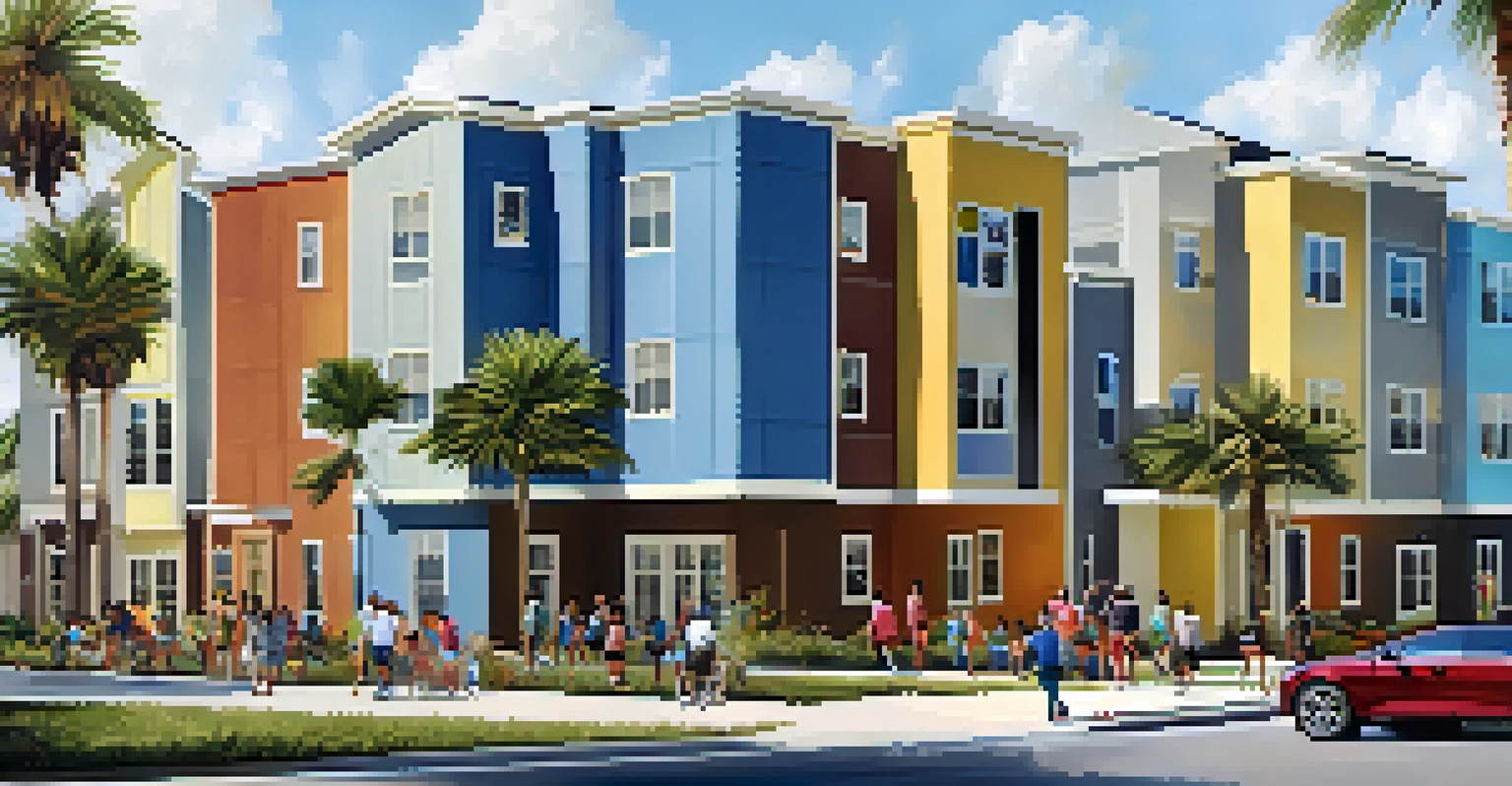Affordable Housing Trends in Tampa: Challenges and Solutions

Understanding Tampa's Affordable Housing Crisis
Tampa is experiencing a growing affordable housing crisis, as demand consistently outpaces supply. With a booming population, many residents find it increasingly challenging to secure housing that fits their budget. This situation is exacerbated by rising property values and rental prices, creating a perfect storm for low-to-middle-income households.
Affordable housing is a fundamental human need, and it is essential for the well-being of individuals and families.
The need for affordable housing is not just a local issue; it's a nationwide concern affecting urban areas across the country. As Tampa continues to attract newcomers for its job opportunities and pleasant climate, the pressure on the housing market intensifies. Without effective solutions, many families may face housing instability, leading to broader social challenges.
Understanding the nuances of this crisis is the first step toward finding viable solutions. By examining factors such as income levels, housing availability, and economic trends, we can better grasp the challenges at hand and work towards a more equitable housing landscape for all.
Key Challenges Facing Affordable Housing Development
Several key challenges hinder the development of affordable housing in Tampa. Zoning laws, for instance, can restrict the types of housing that can be built in certain areas, often favoring single-family homes over multi-family units. This limitation can stifle the creation of diverse housing options that cater to varying income levels.

Additionally, rising construction costs are a significant barrier. Materials, labor, and land prices have surged in recent years, making it difficult for developers to offer affordable units without compromising on quality or profitability. As a result, many projects that could have provided affordable housing are either delayed or shelved.
Tampa's Housing Crisis Explained
Tampa is facing an affordable housing crisis due to rising demand, property values, and rental prices, impacting low-to-middle-income households.
Lastly, the availability of funding and financing options remains a critical obstacle. Many developers rely on government grants or low-interest loans to make projects feasible, but these resources are often limited or competitive. Addressing these challenges requires collaboration between local governments, developers, and community organizations.
Innovative Solutions for Affordable Housing
Despite these challenges, innovative solutions are emerging to address Tampa's affordable housing crisis. One such solution is the promotion of mixed-income developments, which integrate affordable housing units alongside market-rate homes. This approach not only provides diverse housing options but also fosters inclusive communities.
The best way to predict the future is to create it.
Public-private partnerships are also gaining traction as an effective way to leverage resources and expertise. By collaborating, local governments and private developers can share the financial burden and streamline the approval process for new housing projects. This collaboration can lead to faster construction timelines and more affordable units being brought to market.
Additionally, adaptive reuse of existing buildings is a growing trend. Transforming underutilized properties, such as warehouses or schools, into affordable housing can be a cost-effective way to increase supply while preserving the character of neighborhoods. This strategy not only addresses housing needs but also revitalizes communities.
The Role of Local Government in Housing Solutions
Local government plays a pivotal role in shaping the affordable housing landscape in Tampa. By implementing policies that promote affordable housing development, officials can create a more inclusive environment for residents. This includes adjusting zoning regulations to allow for higher density and varied housing types.
Moreover, local governments can provide incentives for developers who commit to building affordable units. These incentives might include tax breaks, grants, or expedited permitting processes, making it more financially viable for developers to invest in affordable housing projects. Such support can significantly boost the number of available units.
Barriers to Affordable Housing
Key challenges such as restrictive zoning laws, rising construction costs, and limited funding hinder the development of affordable housing options in Tampa.
Finally, engaging with community stakeholders is crucial for understanding the unique needs of residents. By hosting forums and gathering input, local governments can ensure that their housing policies reflect the desires and requirements of the community, ultimately leading to more effective solutions.
Community Involvement in Affordable Housing Initiatives
Community involvement is essential for addressing affordable housing challenges in Tampa. Local residents often have a wealth of knowledge about their neighborhoods and can provide valuable insights into what types of housing are needed. Their participation in planning processes can help create solutions that truly meet the community's needs.
Grassroots organizations and advocacy groups play a vital role in raising awareness about housing issues and mobilizing support for affordable housing initiatives. These groups often work to connect residents with resources, such as legal aid or financial assistance, and can advocate for policies that prioritize affordable housing development.
Additionally, community land trusts are gaining popularity as a way to promote long-term affordability. These nonprofit organizations acquire and manage land for the benefit of the community, ensuring that housing remains affordable for future generations. By empowering residents to take ownership of their neighborhoods, these initiatives can foster a sense of community and stability.
The Impact of Economic Factors on Housing Affordability
Economic factors play a significant role in shaping housing affordability in Tampa. Job growth and rising wages can lead to increased demand for housing, placing additional pressure on the market. When people have more disposable income, they tend to seek better housing options, which can drive prices up even further.
Conversely, economic downturns can lead to job loss and reduced income, making it challenging for residents to afford their homes. This cycle creates a delicate balance that local policymakers must navigate to ensure that housing remains accessible, regardless of economic fluctuations. Providing support during downturns is crucial for maintaining stability in the housing market.
Collaboration for Housing Solutions
Innovative partnerships between local governments, developers, and communities are essential for creating effective solutions to Tampa's affordable housing challenges.
Moreover, the availability of affordable financing options is vital for both homebuyers and renters. Programs that offer down payment assistance or low-interest loans can help individuals secure housing without facing crippling debt. By addressing economic factors that impact affordability, Tampa can move toward a more sustainable housing market.
Looking Ahead: The Future of Affordable Housing in Tampa
As Tampa continues to grow, the future of affordable housing hinges on collaboration and innovation. By embracing creative solutions and fostering partnerships between various stakeholders, the city can work toward creating a diverse and inclusive housing market. This collective effort is essential for ensuring that all residents have access to safe and affordable housing.
Furthermore, ongoing community engagement will be critical in shaping the future of housing in Tampa. By listening to the voices of residents and incorporating their feedback into planning processes, the city can develop policies that truly reflect the community's needs and aspirations. This approach not only fosters trust but also empowers residents to take an active role in shaping their neighborhoods.

Ultimately, the journey toward affordable housing in Tampa requires a shared commitment to addressing the challenges at hand. With a focus on sustainable development, community involvement, and innovative solutions, the city can pave the way for a brighter future where everyone has a place to call home.